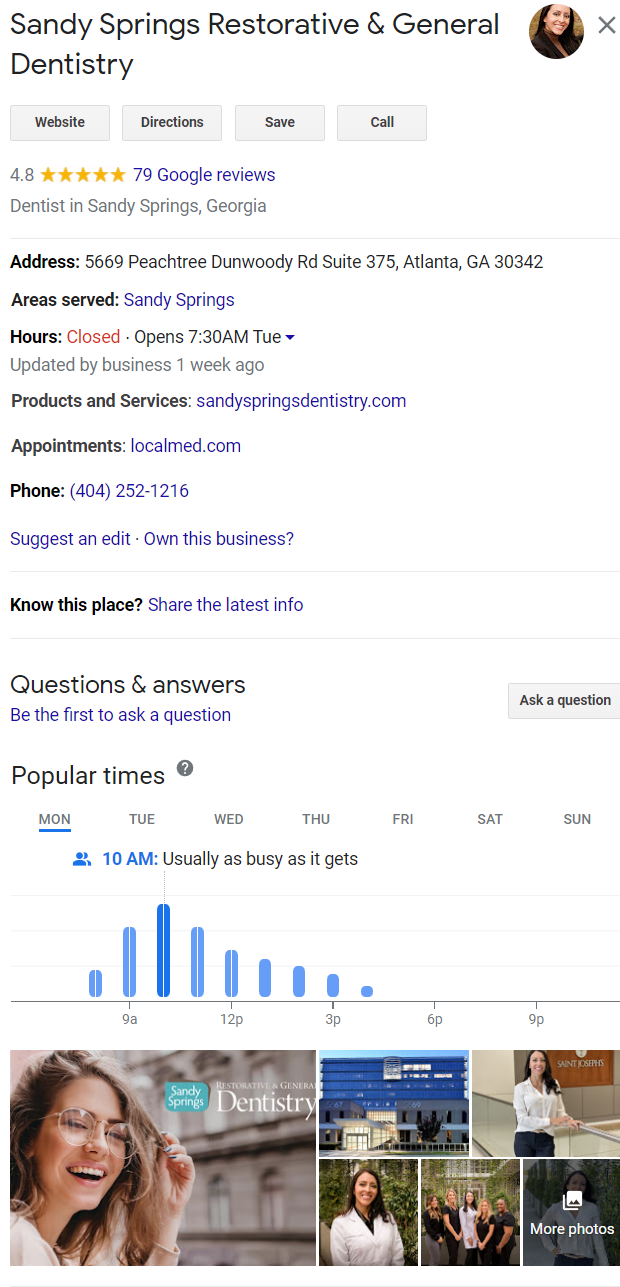Do you have your 2023 marketing strategy in place yet? The multi-location healthcare groups we work with are hard at work on their new-year planning. Under our guidance, they’re evaluating past performance, identifying potential investments, and determining their strategic direction for this year. The healthcare industry has changed significantly due to the acceleration of digital transformations, post-pandemic recovery, and the recessive economy we have found ourselves in. Healthcare providers are now having to pivot their strategy to adapt to new challenges. New patient volume and provider recruitment are more important than ever in 2023.
So we’re giving you what we give our healthcare partners: our recommendations for a stronger 2023 digital marketing plan. What follows are some trends and best practices to keep in mind as you assess your strengths and weaknesses.
As you’ll find, there’s some low-hanging fruit here that you might have overlooked up to this point. Anything to gain the edge in what will be a wildly competitive healthcare market.
Prioritize Your Digital Presence
Take it from us: you can’t afford not to commit more aggressively to your digital presence. When it comes to healthcare journeys, all roads lead to your website. A sloppy, disorganized website is a dealbreaker. Your visitors will just go somewhere else to find what they need (probably a competitor).
What to Focus on For Improving Your Digital Presence
Don’t jump headlong into top-of-funnel advertising and social media until you get your website in order. Build a strong foundation that’s aligned with technical, SEO, and UX best practices. To get there, we recommend a comprehensive website audit that examines:
- SEO health and performance
- Mobile experience and speed scoring
- Online scheduling experience
- Technical red flags and information architecture
- Design and user experience
- Content (top-performing, redundant, unnecessary, outdated)
Align Your Strategy with Your Marketing Maturity
Throwing everything at the wall to see what sticks is not a sustainable strategy. Depending on the maturity of your marketing operations, only certain strategies will make sense to implement. Build your strategy based on the maturity of your marketing operation. Ask yourself:
- How strong is your lead pipeline, and are leads actually converting into patients?
- Are your customer acquisition costs sustainable?
- Is paid traffic converting into new leads? Or can conversion rates be improved?
- Do you have strong brand awareness and equity?
Make an honest assessment to avoid overstretching yourself. Here are a few common scenarios that help illustrate the point.
Example 1: You need to generate leads quickly but lack brand awareness
This is the reality for a lot of multi-location healthcare groups. We recommend pay-per-click (PPC) advertising in this situation. Organic SEO strategies aren’t going to generate leads as quickly as you need. Top-of-funnel advertising on Facebook might seem like a good idea to grow awareness, but Google is where patients go to begin looking for care. Invest in bottom-of-the-funnel paid search campaigns to capture the leads that are looking for care now.

Example 2: You dominate search results with organic listings and PPC ads
In this case, it’s time to turn more of those clicks and traffic into actual patients. This is where we recommend investing in conversion rate optimization (CRO), the practice of assessing the pre and post-click experience and identifying opportunities to increase conversions. CRO goes beyond simply changing button colors. It’s about evaluating if users’ information needs are being met, removing conversion barriers, and shortening the path to a new appointment, purchase, etc.
Example 3: Your patient churn is out of control
Your strategy should focus on new ways to build brand loyalty or improve patient retention, of which marketing can play a central role. Look for opportunities to improve the patient experience (appointment scheduling and follow-up, for example). Consider social media and public relations campaigns or online community building that help strengthen your brand’s reputation.
Example 4: Lead quality isn’t very good
If your leads aren’t converting to actual patients, you’re not attracting the right leads. Reexamine your unique selling proposition (USP) and make sure it’s communicated throughout your content, ads, etc. Refine your keyword strategy, too.
Keywords are how people find you. If you’re using the wrong words or ranking for other keywords, or use the wrong language in ads, you could attract the wrong prospects. Lastly, tell the algorithms what happened to conversions (forms and calls). Push patient data back to Google and Facebook so the algorithms can optimize to find more people likely to convert. When preparing your 2023 healthcare marketing strategy, pay close attention to the different parts of the patient funnel and where prospects are potentially falling off.
Example 5: You have aggressive goals for new patient acquisition
Do an analytical deep dive to determine your actual market penetration. Some of your campaigns might be performing too poorly to support rapid patient acquisition. Think about new digital advertising channels, adjustments to your keyword strategy, or changes to your current media mix. Market expansion might be in order, too. Are there viable opportunities to begin new locations/affiliates into the fold?
Build a Foundational SEO Strategy
It’s very important to develop SEO strategies and content that work across the funnel. This is the only way that you’ll rank for keywords at each stage of the patient journey and each level of intent. You can use SEO tools like Google Analytics, Moz, or Semrush to get baseline information about your SEO health.
If you don’t have strong organic visibility, rankings, and traffic, consider investing in a more comprehensive SEO strategy and content. Remember that it takes time to generate quality organic site traffic, but SEO is truly part of your marketing foundation. For multi-location healthcare businesses, in particular, you’ll struggle to compete online without a strong technical SEO foundation and high-value content across the entire funnel.

SEO can feel like a big bad monster for some healthcare groups. Start with your local search strategy, where you’ll find plenty of lower-effort optimizations that translate into results.
- Update your business listings (Google My Business, Yelp, Facebook Business)
- Create and optimize the location pages on your website
- Develop and/or refine your local keyword strategy
- Revisit your service pages to add more content and media
Adopt a Full-Funnel Strategy
Healthcare consumers don’t follow a linear path. Depending on the intent, certain channels and messages are more effective than others. Healthcare consumers sometimes move to and from different stages in the funnel in ways that defy logic. The key is to understand consumer intent within digital interactions and how you can give them what they want at each point in the journey.
Jacqueline Ruma, VP, Sr. Director of Media & Analytics from Smile Doctors, talks about the intricacy of patient funnels in a recent webinar:
“I know a lot of times we get caught up in KPIs and digital tactics and how we are going to drive one extra lead to get one extra sale. If you are not balancing that with your storytelling and providing prospective patients with the reasons to believe in your brand, then you’re missing an opportunity.”
When preparing your 2022 healthcare marketing strategy, pay close attention to the different parts of the patient funnel and where prospects are potentially falling off.
Top-of-Funnel: Brand Awareness and Demand Generation
At the top of the funnel (TOF), it’s all about providing value and educating. At this point, healthcare consumers are at least aware of a healthcare need. It may be new symptoms or dissatisfaction with a provider. They’re unsure of what to do and need guidance.
At this stage in the funnel, you need to answer questions, ease fears, and provide authoritative information. Educate people about high-consideration healthcare decisions, such as surgeries, care facilities, and hospice. Develop content that’s both search-friendly and authoritative so people can find you when they Google.
This is also an opportunity for some brand storytelling that communicates your unique selling proposition (USP). This might include top-of-funnel social media campaigns focused on educational brand building.
Middle of Funnel: Meeting Needs
At the middle of the funnel, healthcare consumers understand what they need a little better and might be considering your particular organization. They need a second opinion, for example, in a particular service area. However, they also need more information to inform their decision or compare providers. This might include educational content and customer testimonials.
Here’s a strong example of a middle-of-funnel testimonial:
Bottom of the Funnel: Convert and Cultivate Loyalty
At this stage in the funnel, you will convert people into new patients and, hopefully, give them an outstanding patient experience. Your reviews and reputation management will be very important at this stage. Your quality of service, communication, and follow-up will all contribute to patient loyalty, too. Remember that the bottom of the funnel is a prime opportunity to capture existing demand and win patients that need immediate help.
Bonus: Customer Engagement and Brand Evangelists
Your social media can be an effective way to support patient retention, engage patients, and fuel recurring revenue. This can be a rich source of word-of-mouth recommendations, too. Ultimately, you must find the right balance between activation, lead generation, and brand building. It really comes down to understanding your market position, goals, and so on. From there, you can figure out how brand building and lead gen work together to support each other better than if alone.
“It’s a delicate dance, and it’s a balance that you have to find, and not every situation allows for you to have the same balance of storytelling and activation. In your paid search initiatives, you’re not going to have as much of an opportunity to tell your brand story, but you may have an opportunity through public relations to have one of your doctors interviewed to be able to lean into what your brand story is, which may ultimately help drive SEO once you link that on your website and people and people start looking for the article.”
Let’s Be Bold and Adaptable in 2023
Healthcare marketing is all about measuring and adapting. Look at and listen to what the data is telling you because it’s what new and prospective patients are telling you. They’re already telling you what’s working, what’s not, and what’s reasonably achievable in the future. And they’ll tell you where to dial things up or down in 2023. The main thing is to put a foundational, cross-funnel strategy in place, one you can build on and scale when the time comes.

